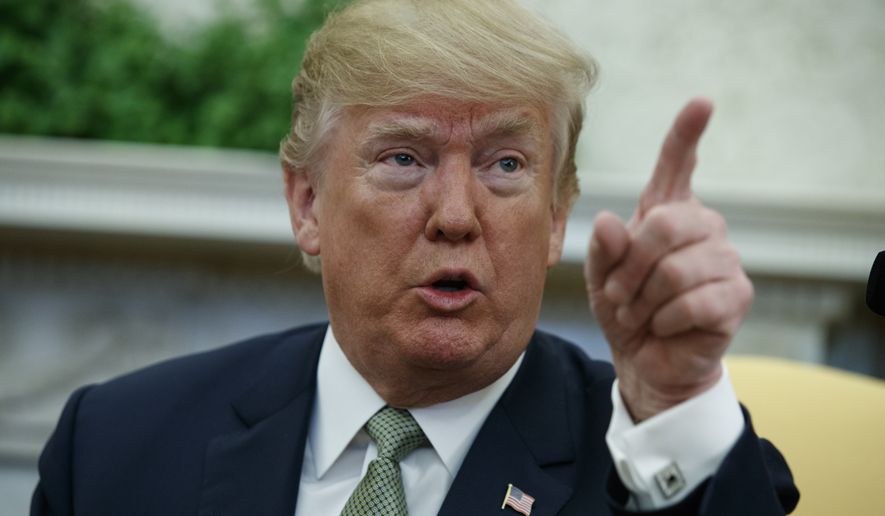President Trump’s “phase two” tax cut plan, which would make permanent last year’s personal income tax reductions and possibly slash capital gains rates, is more of an election-year strategy to corner Democrats right now than it is an actual proposal.
While the president has promoted the plan twice this week publicly, the White House hasn’t put forward a proposal yet to Congress. White House aides say it’s still in the idea stages as Mr. Trump awaits the arrival of his new chief economic adviser, Larry Kudlow.
“We don’t have specifics of an actual proposal or a timeline just yet,” White House principal deputy press secretary Raj Shah said Thursday on Fox Business Network.
But Republicans say talking about the plan now serves another useful purpose — reminding voters in the midterm election year that not a single Democrats voted for the tax cuts that are showing up now in paychecks, and rekindling House Minority Leader Nancy Pelosi’s dismissive comments about bigger paychecks and company bonuses as “crumbs.”
Kayleigh McEnany, a spokeswoman for the Republican National Committee, said this week, “Democrats would be wise to get on board. They didn’t get on board with the first round of ’crumbs,’ as Nancy Pelosi said. They should get on board with the second.”
Also, the “phase two” proposal is a promise to voters that they wouldn’t face a big tax increase after 2025, when the current tax cuts are due to expire.
“Fighting to make middle-class tax cuts permanent is smart politically and smart policy,” said Republican strategist John Feehery.
There’s polling evidence to show why Republicans believe they should keep running on tax cuts this year. A survey last month by the website LendEDU found that 48 percent of respondents believe they will be able to retire sooner due to the tax changes, and 55 percent were more confident in their financial future.
In the survey, 50 percent of the 1,000 people polled said the tax cuts made them feel more positive about Mr. Trump, while 43 percent said their sentiment had not changed and 6 percent said they felt more negative about him.
A Zogby Analytics poll released March 1 found Mr. Trump’s job-approval rating at a high of 48 percent, partly due to the tax cuts. And generic congressional polls in recent weeks have shown that Republicans have closed the gap with Democrats to within about five percentage points, after being behind by 18 or more points.
But the first test of the tax cuts’ popularity in an election didn’t favor the GOP this week. In Pennsylvania’s 18th Congressional District southwest of Pittsburgh, Democrat Conor Lamb narrowly defeated Republican Rick Saccone, Mr. Trump’s endorsed candidate.
At a GOP fundraiser in Missouri on Wednesday night, Mr. Trump said Mr. Lamb won because he ran like a Republican and supported the tax cuts.
“He said, ’Oh, I’m like Trump. Second Amendment, everything. I love the tax cuts, everything.’ He ran on that basis,” Mr. Trump said, according to an audio recording of the event. “He ran on a campaign that said very nice things about me. I said, ’Is he a Republican? He sounds like a Republican to me.’”
While Mr. Lamb did embrace the president’s tariffs on steel and aluminum, he didn’t support the GOP tax cuts. He called them a “giveaway” to the wealthy and a “betrayal” to middle-class households.
Mr. Shah said “phase two” is a no-brainer after the runway success of the first tax cut law.
“There was so much success — more success than we could have predicted with hundreds of company announcing bosses, announcing wage hikes, all sorts of announcements form the first tax cut bill,” he said. “Why not do it again?”
Deficit hawks warn that making the tax cuts permanent, without other changes in spending, will add to annual budget deficits that are already nearing $1 trillion.
The Committee for a Responsible Federal Budget issued a report Thursday showing that the federal government’s interest payments alone on the national debt could top $1 trillion per year soon.
“While interest had already been projected to rise rapidly, the recent tax and budget deals will significantly accelerate that growth,” the group said.
Last year, the federal government spent $263 billion on interest, or 1.4 percent of gross domestic product. By CRFB’s estimates, annual interest spending will rise to $965 billion, or 3.3 percent of GDP, in 2028. The 3.3 percent of GDP would be the highest on record.
Still, House Republican leaders are looking at a bill sponsored by Rep. Rodney Davis, Illinois Republican, that would make the tax cuts permanent.
“I’d like to see that bill move forward and there’s a lot of interest,” House Majority Whip Steve Scalise, Louisiana Republican, said Thursday on Fox. “Now’s not time to turn back the clock and let Nancy Pelosi be Speaker. That’s why November is so important.”
• Dave Boyer can be reached at dboyer@washingtontimes.com.
• S.A. Miller can be reached at smiller@washingtontimes.com.




Please read our comment policy before commenting.